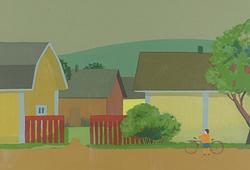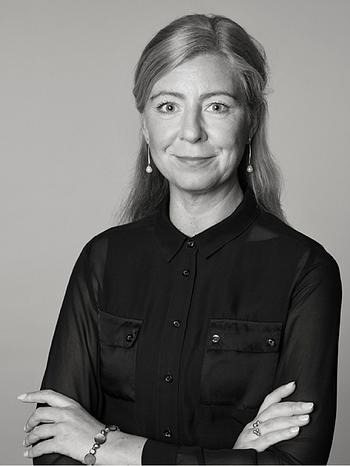Henri Laurens
"La Banderole"
Signed HL and numbered 3/6. Conceived in 1931. Foundry mark Cire Perdue C Valsuani. Bronze, brown patina. Height 36,5 (14 3/8 in.), length 33 x 26 cm (13 x 10 1/4 in.).
Note: If your online bid exceeds SEK 3 million, you will need a bank reference. Please contact our customer service to be cleared for this level of online bidding.
Alkuperä - Provenienssi
Galerie Louise Leiris, Paris. (Ph. no 7794).
Svensk-Franska Konstgalleriet, Stockholm, Sweden, 1965.
Marabousamlingen, Sundbyberg/Upplands-Väsby, Sweden (acquired from the above).
Kraft Foods Sverige AB, Upplands-Väsby, Sweden.
Kirjallisuus
Werner Hofmann, "Henri Laurens", 1970, another cast illustrated full page, p. 131 and catalogued under the title "Das Band", page 218.
Ragnar von Holten, "Art at Marabou", 1990, illustrated and mentioned p. 28.
Muut tiedot
Receipt from Svensk-Franska Konstgalleriet, Stockholm enclosed.
Henri Laurens was born in Paris in 1885 and began sculpting at the mere age of 13. He worked in a construction and decorating firm, where he acquired a knowledge of materials and made sculptural ornaments when he was young. In the evenings, he took drawing classes and learned to translate three-dimensional form into skilful charcoal drawings on paper. He became famous for his sculptures based on human bodies, especially women. In 1902, he moved to Montmartre, the artist quarters in Paris, where the new century brought the winds of change and innovation to art. He met Marthe Duverger in 1905. They married, and Marthe became his first model, whom he sculpted according to the Greco-Roman ideals. At this time, he was influenced by Auguste Rodin, but when he met Georg Braque in 1911, however, his style changed. They became close friends, and Laurens let himself be influenced by Braque’s Cubist experiments. Laurens developed his own strongly Cubist imagery that he expressed in paper collages and wood-and-metal sculptures in the 1910s. One of Laurens’ earliest and most intriguing works from this period, a composition reduced to lines and angles, is now in the Moderna Museet collection in Stockholm (Clown, 1915).
Picasso admired Laurens’ Cubism and introduced him to Léonce Rosenberg, who presented his first solo exhibition in Paris in 1918. Rosenberg acquired several works and became a long-standing patron of Laurens. His first exhibition, which was well-received by the critics, was followed by many others in the 1920s, mainly at the now-legendary Galerie Simon, which was reopened after the First World War by Daniel-Henry Kahnweiler on his return from exile in Switzerland. Many of the sculptures he exhibited at this time were inspired by Jacques Lipchitz and African sculpture, although in a Cubistically geometric style. Laurens also managed to introduce nature and developed an organic, curvaceous and abstractly rhythmic style, expressed predominantly in nude, lyrical and powerful female figures. Laurens made these representations of standing, reclining and seated women in bronze, terracotta clay and stone. His style mellowed with age, and the shapes became denser. In the early 1930s, he combined the Cubist idiom with more organic design and allowed sensuality to triumph over all theories and stylistic ideals, as expressed in his famous stone sculpture “Crouching Figure” (Seated Woman) from 1930 (Centre Pompidou, Paris). Laurens gradually modified his Cubism towards a personal formal idiom that was characterised by more mature, full and rhythmically rendered volumes, based on oceanic and mythological subject matter. The sea was a vital source of inspiration for Laurens, possibly because he was 47 before seeing it! Through his art, he explored imaginary oceans and the movements of its creatures.
The bronze “La Banderole”, made in 1931, is one of the finest examples of his unique style from this period. He was at the height of his artistic career at this time, and there was a great demand for his works among initiated collectors and art institutions. The Throne-Holst family, who were familiar with the works of the French sculptor, purchased the monumental “Les Ondines” for the Marabou Park in Sundbyberg already in 1951. “Les Ondines” which was cast in lead in 1934, is a representation of the ocean personified by mythological female figures lying side by side on the crests of softly rounded waves. “La Banderole” was purchased in 1965 through Svensk-Franska Konstgalleriet in Stockholm, which had excellent connections with the Parisian Galerie Louis Leiris, where "Les Ondines” had been acquired. In "La Banderole” Laurens embodies the essence of woman, and his striving to achieve compact volumes is immortalised in durable bronze. Although the style is distinctly Cubist, the sculpture nevertheless has an organic and sensual appeal. Six bronze casts were made of “La Banderole”, and can be found in the Museum Frieder Burda, Baden-Baden (Ulla and Heiner Pietzsch collection, Berlin) and in the Musée des Beaux-Arts in Lyon, France.
The first time the Swedish public had the opportunity to see Laurens’ work was in a seminal group exhibition featuring Georges Braque, Henri Matisse, Pablo Picasso and Henri Laurens, which toured to Oslo, Copenhagen and Stockholm in 1938. Galleri Samlaren, under the capable auspices of Agnes Widlund, and Svensk-Franska Konstgalleriet, which was ruled by Gösta Ohlson, also organised several exhibitions with Laurens, on his own or together with the artists listed above. Alberto Giacometti, who often expressed himself scathingly about art critics and art essayists, rarely wrote about art, but nevertheless praised Laurens for his greatness and how his sculptures served as three-dimensional shadows of the artist’s breath, mind and touch.




























